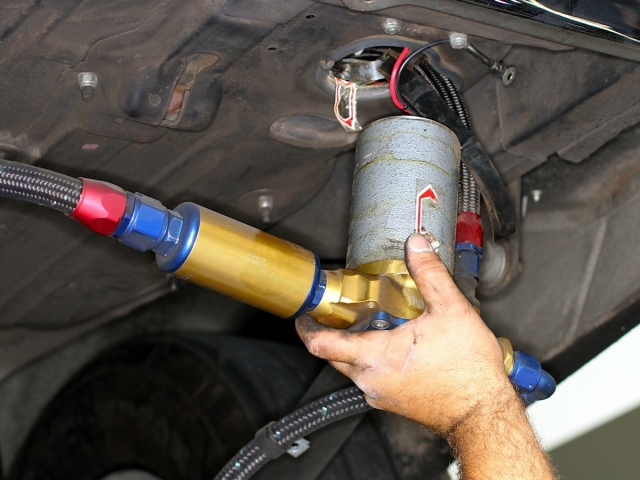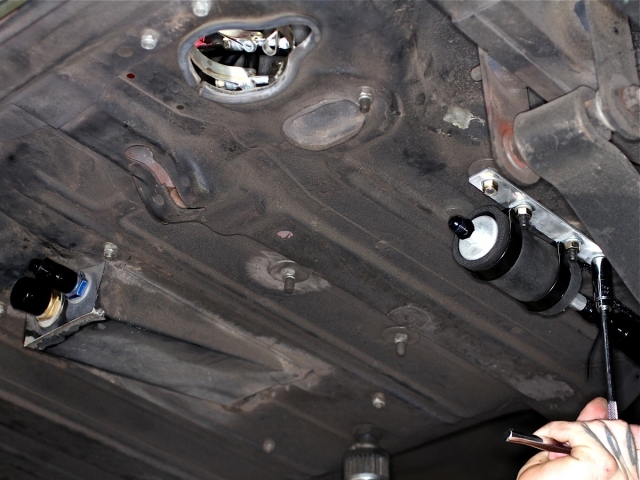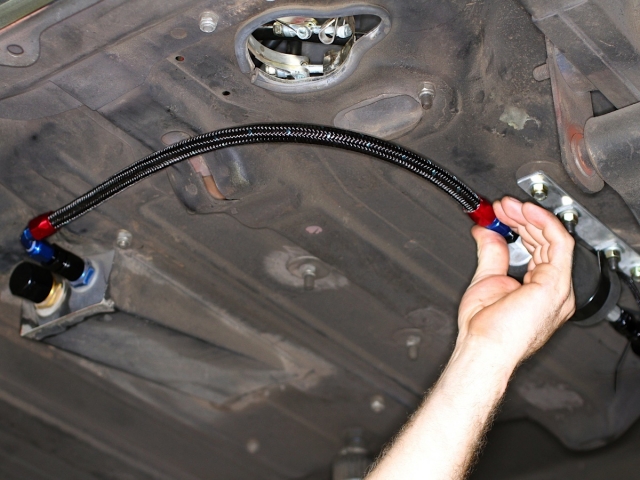Almost everyone agrees that electronic fuel injection systems are easier to start in colder weather, get better gas mileage, have better throttle response, keeps random cylinders from running rich or lean and provide lower emissions than their carbureted counterparts. Because of the very nature of electronic fuel injection, constant monitoring of the air/fuel ratio, a great case for engine longevity can also be made.
So take a guess – Does a system that works so well, provides so many benefits and is good for the environment require an expert with a gazillion years experience to convert to an EFI system?
With an in-tank pump, the life of the pump is much better. – Brian Reese
Would it surprise you if we said that no special experience is required. If you have even a basic set of mechanical skills, converting to an EFI system can be performed within a weekend with no problem.
We did just that and put the system to a test on our Dynojet chassis dyno to see the results. The installation and dyno results can be found in this article: Installing FAST EZ-EFI 2.0. If you have ever wondered how to setup a fuel system for electronic fuel injection, we got with the experts at FAST to discuss what things need to be considered and what options you have when installing the perfect fuel system to support an EFI unit.
We recently installed FAST's EZ-EFI 2.0 system on Mark Rapp’s 1970 Nova. We did some testing and the rear fender shows the signs of real world burnout testing.
What Is A Return Style Fuel System?
FAST EZ-EFI 2.0 Highlights
- Carb replacement system supports stock to 1200 hp engines.
- Revised self tuning strategy. Setup wizard guides user through start-up and tunes itself as you drive – No need for a laptop or previous tuning experience.
- Advanced color touch screen hand-held/sensor dash – includes suction cup mount and shares same mounting points as Garmin Nuvi GPS.
- Integrated fuel pulse damper that creates extremely precise fuel control.
- Return-style or Return-less fuel systems are supported.
- High-quality harness with mesh loom and wide-band O2 included.
- Throttle body features Holley carb-style throttle linkage and 4150 bolt pattern, 8-injectors, and commonly available OEM sensors.
- Works with original carb type distributor but offers optional electronic ignition control with Nitrous timing retard.
- E85 compatible.
One of the two major decisions when converting to an electronic fuel injection system is whether to use a return or return-less fuel system.
The other decision, an in-line or in-tank fuel pump is loosely tied to the type of supply system you decide to use.
According to FAST engineer Brian Reese, “Return-style systems constantly pump fuel in a circuit starting at the fuel tank, running up to the engine and the excess fuel is returned to the fuel tank.”
A fuel pressure regulator is used to control the fuel pressure in this type of fuel system.
Pros of Return Style Fuel System
- Maintains a consistent fuel pressure and fuel flow which can extend the range of fuel injectors and help them function better at lower fuel demands
- Keeps fuel pump cooler
- Virtually eliminates vapor-lock
- Provides fuel for higher horsepower applications without special fuel pumps or multiple fuel pumps
Cons of the Return Style Fuel System:
- Increased EVAP emissions
- Aerates the fuel at the return line as it is dumped back into the fuel tank
Many technicians claim that the return-style fuel systems are more consistent with fuel pressure and fuel flow. Because the excess fuel is cycled back to the fuel tank, a larger amount of fuel is circulated through the system, which helps keep the fuel pump cooler.
Many technicians also say that a return-style system eliminates vapor-lock. When fuel gets too warm it releases volitile compounds into the system in the form of gasses.
This off-gassing creates gas bubbles in the fuel line disrupting the engine’s operation. This is referred to as vapor-lock when there is enough of a disruption to keep the engine from running.
The unintended side effect of a return-style system is increased evaporative fuel vapor emissions (EVAP Emissions).
Because the extra fuel has been routed through the engine compartment, it carries a lot of engine heat back to the fuel tank and increases evaporative fuel vapor emissions or off-gassing at the tank.
Returnless Fuel System
A returnless fuel system is a one-way trip for the fuel. The pump pulls fuel from the fuel tank and sends it to the engine for use. There is no excess fuel to pump back to the fuel tank because the fuel pressure is controlled at the pump. There are actually two types of returnless fuel systems: mechanical and electrical. The mechanical system uses a mechanical fuel regulator at the pump to control the pressure to the engine.

The first decision that needs to be made is whether to use a return line (return-style system) or to go with a returnless fuel system. The return system is favored by many EFI technicians for multiple reasons. The system pictured above is a return system with an in-tank fuel pump.
An electrical type returnless fuel system, like the EZ-EFI 2 system, controls fuel pressure at the pump by varying the speed of the pump. Often referred to as the “on demand” EFI returnless system, they are most commonly used on a throttle body EFI system that has an airflow sensor to monitor the engine load.
Obviously the plumbing for a return-less style EFI fuel system is much more simplified without having to plumb a return line. Putting the pump into the tank keeps it away from engine heat and extends its life. The only downside with an electrical return-less system is servicing or replacing the in-tank fuel pump if it needs replaced for any reason.
Many times the return-less systems operated at a higher pressure than return-type systems. This is done to reduce the risk of fuel boiling and vapor lock in the supply line at the engine during hot whether.
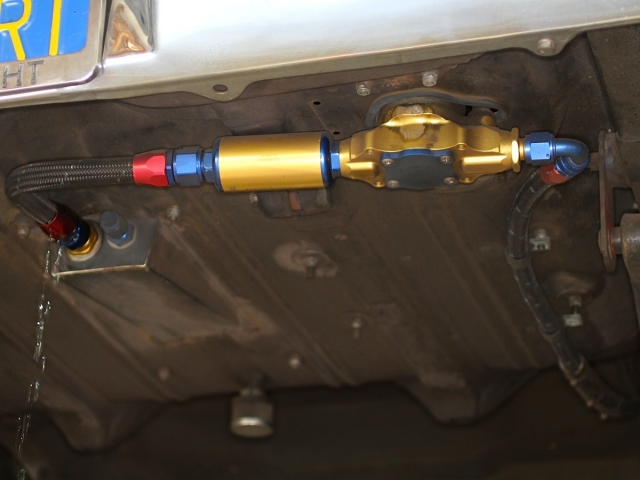
This Nova already had a decent fuel system due to its race background, so we elected to stay with the return-less system already in place. We started by draining the fuel system.
FAST offers both return and returnless fuel system kit for EFI applications – they strongly recommend a return style system; however, “we do offer a return-less system which includes the required rotor vane style in-tank pump as well as the proper relay,” says Reese. “The kits include everything you need to convert to an EFI system.”
Pros of Returnless Fuel System:
- No aeration of fuel because of fuel returned to the tank
- Less hardware to install
- Takes less space
Cons of Returnless Fuel System:
- Pumps may be louder than the Return style fuel system
- Less pump life than Return style system
- More heat in the fuel system than the Return style
Pumps – In-line or In-tank
Like the name implies, an in-tank pump is when the fuel pump is located inside the fuel tank itself. Most late model automobiles come with this style fuel pump now. An in-line pump is mounted in the main fuel supply line somewhere between the fuel tank and the engine. Either of these will work with an EFI conversion but in-tank pumps are preferred over the in-line pump for several reasons.
According to Reese, “With an in-tank pump, the life of the pump is much better. First, it’s cooled by the fuel that surrounds it in the tank and secondly, electric fuel pumps are much better at pushing the fuel than drawing the fuel out of the tank.
“Because the in-tank pump is more efficient pushing the fuel through the system, the pump is able to supply more fuel, more efficiently, and not experience any priming issues that may occur with in-line pumps,” Reese adds.
In-line pumps can be easier to install in many cases but are sensitive to the mounting locations. “In order for in-line pumps to draw the proper amount of fuel from the tank, they must be mounted close to the tank and lower than the lowest point of the fuel tank in order to properly prime,” advises Reese. “I would recommend the in-tank always. Even if this means replacing your old tank. Chances are that your old tank has some dirt and rust in it and probably needs replaced anyway. At a bare minimum, drop the tank to clean and inspect it,” he said, “then install one of the FAST bolt-in EFI pump kits.”
Rust and dirt in the tank will eventually get into the system and plug the fuel filter or restrict the fuel flow in the line. The filters on most return-less EFI applications are “lifetime” filters with no scheduled replacement interval. Normally these should last upwards of 100,000 miles, but they won’t last that long if the vehicle has rust or dirt in the gas tank.
There are those rare occasions, like our project car here, where you have no choice but to utilize an in-line pump. As Reese explained earlier, “in those cases where you have to use an in-line pump, mount it as close to the tank and lower than the fuel tank for best results.”
How it Works
Once the system has been plumbed for either a return-style or return-less type system, the set up gets very simplified. One of the greatest features of electronic fuel injection systems is that they don’t need to be tuned or tweaked the way carburetors do. Many EFI systems, like the EZ-EFI 2, will even correct itself for changes in altitude and weather, providing the best mileage possible no matter what the conditions are like, which is something a carburetor is simply not capable of.

The system’s ECU was mounted in the upper engine firewall in the passenger compartment where the heater/blower unit used to be. The ECU receives signals from the sensors and determines how long and when the injectors need to be open.
The process of information that occurs in the Electronic Control Unit (ECU) is far more complicated than can be explained in this article but in the simplest of terms, the ECU has a series of data tables programmed into its memory which list a value of all the sensors at different parameters. The ECU will look in the tables and match the sensor value with the proper fuel value. The goal is to provide an air/fuel ratio near 14.7:1, which is known as stoichemetric. In theoretical combustion terms, stoichemetric is the ideal combustion process where fuel is burned completely.
Fuel is metered through fuel injectors in the throttle body by pulsing their internal valves to open and close at an extremely rapid pace measured in milliseconds (ms). While the engine is running, the ECU is constantly updating the fuel injector’s open to close time, known as the pulse width (PW) and the time between pulses, known as the pulse interval (PI) based on information received from various sensors. As the engine demand for fuel increases, the sensors relay that requirement to the ECU, which looks in the tables for the corresponding injector pulse width and pulse interval to meet the demand. The ECU can infinitely adjust the fuel flow to match engine demand under any possible condition and at any point in time.
We opted to test the FAST EZ-EFI 2.0 primarily because of the full system package in one kit mentality. Our previous dealings with FAST has shown that their kits are complete and chocked full of top end components like Walbro fuel pumps and their own self branded electronic control units programmed by FAST engineers. Just like our previous experiences with FAST, we were not surprised with the upgrades to the new system. FAST has been well-known for making bold changes and adding the latest technology in each unit they release.
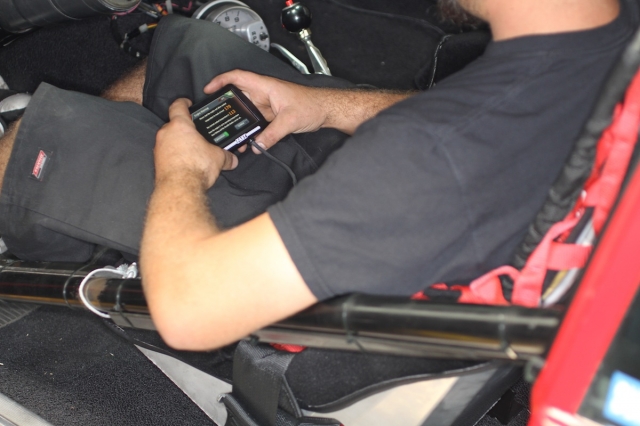
The handheld controller is a display and interface for the user. Completely menu driven, the user inputs information requested by the ecu to set the unit initially. After the initial set-up, the system begins learning the driver’s habits and the vehicle requirements by itself.
FAST EZ-EFI 2.0 Practical Application
FAST’s Dan Hodgdon explained that the EZ-EFI 2.0 kit we chose for this project upgrade was a stand alone kit that “simply tunes itself as the user drives.” According to Hodgdon, “Its eight-injector, die cast throttle body features late-model OEM sensors for accuracy and durability. The system supports up to 1200 horsepower and includes ignition timing control and is able to run E85 fuels, which makes it a perfect system for daily drivers on pump gas as well.” Numbers show that the EZ-EFI 2.0 flows more air than the first generation EZ-EFI throttle body due in large part to an improved inlet.
The system also features a new secondary shaft throttle stop adjustment that provides even more precise idle airflow adjustment and balance. Hodgdon also explained that the system also has an exclusive feature not seen in many EFI systems. “The integrated fuel pulse damper is an industry exclusive and unique to FAST products.” Much like other types of fuel pulsation dampers, the EZ-EFI regulates the oscillation of fuel created by the injectors opening and closing at a rapid pace. With the integrated pulsation damper, there is no need for aftermarket products to create and regulate a stable and smooth flow.
The EZ-EFI 2.0 also incorporates needle-bearing supported shafts instead of bushings, which greatly enhance performance and longevity. The shafts operate smoothly and will not suffer from bushing wear. The throttle body has an integral fuel rail designed with crossover for a compact and tight package.
The system is compact and uncluttered under the hood. Add a FAST air cleaner with high flow and you're ready to hit the strip.
Converting from carbureted to an electronic fuel injection system is easier than ever and there are plenty of great reasons to consider making the swap. Performance and long term economy are only a couple of the most tangible reasons to swap.
As far as routine maintenance goes, the consumables are easy to find OE style components. All of the sensors can be replaced with OE sensors found at your local parts store. There’s nothing exotic or too difficult to locate which would keep your pride and joy off the road for significant periods of time. Quite the contrary, as a matter of fact, the EFI system will make your daily driver even more dependable.
The real value in the latest EFI conversion systems to hit the market, like FAST’s EZ-EFI 2.0, is the self tuning features. You don’t have to be a tuning expert with decades of experience for the system to run optimally. The system will learn and adjust the parameters by itself. The FAST conversion kit allows the Do-It-Yourself’er to convert from a carb to a modern EFI system and take advantage of all the benefits that an EFI system brings, and THAT is a good thing.








